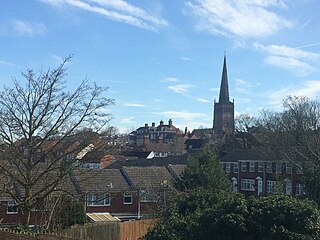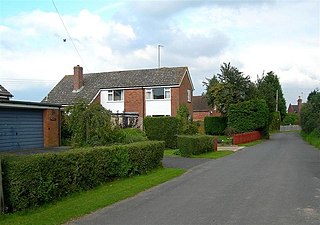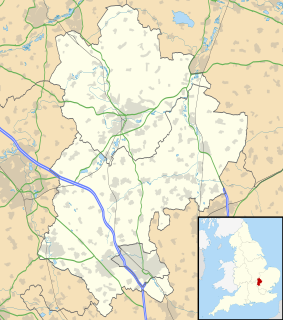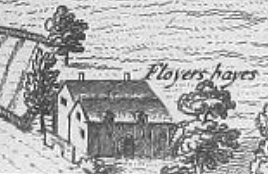
Walsall is a market town and administrative centre in West Midlands County, England. Historically part of Staffordshire, it is located 9 miles (14 km) north-west of Birmingham, 7 miles (11 km) east of Wolverhampton and 9 miles (14 km) from Lichfield.

Sutton Coldfield or the Royal Town of Sutton Coldfield known locally as Sutton, is a civil parish and large suburban town in Birmingham, England. The town lies about 7.5 miles northeast of Birmingham city centre and borders the Staffordshire district of Lichfield and the suburb of Erdington. Historically in Warwickshire, it became part of Birmingham and the new West Midlands metropolitan county in 1974. In 2015, the town elected a Parish/Town Council for the first time in its recent history.
Shelvock Manor is a house and grounds in a township of the same name near Shrewsbury, Shropshire, England. It was once a place of local importance, and was for more than two centuries the seat of the Thornes, a leading family in Shropshire. The first recorded spelling of Shelvock was Shelfhoc (1175), and later Sselvak and Schelfac. The name is most likely derived from the Saxon "ac" meaning oak, prefixed by its location on a shelf or hill.

Coleshill is a market town in the North Warwickshire district of Warwickshire, England, taking its name from the River Cole, on which it stands. It had a population of 6,481 in the 2011 census and is situated 10 miles (16 km) east-northeast of Birmingham, 8.5 miles (13.7 km) southeast of Sutton Coldfield, 11.5 miles (18.5 km) south of Tamworth and 12.5 miles (20.1 km) northwest of Coventry by road.

Coxwold is a village and civil parish in the Hambleton District of North Yorkshire, England and located within the North York Moors National Park. It is situated 18 miles north of York and is where the Rev. Laurence Sterne wrote A Sentimental Journey.

Brimpton is a mostly rural village and civil parish in West Berkshire, England. The village occupies a few square miles of land between the Kennet and Avon Canal, a long tributary the Enborne which is used as part of the Hampshire boundary and the winding slopes of an escarpment in the far south-east, beyond the Enborne which is almost contiguous with the larger settlement of Baughurst a wood-buffered part of Tadley post town. This high common field contains five round barrows from the period of the Heptarchy in Anglo Saxon England.

Little Witley is a village and civil parish in the Malvern Hills District in the county of Worcestershire, England.

Rushall is a large village in the Metropolitan Borough of Walsall, West Midlands, England, centred on the main road between Walsall and Lichfield. It was mostly developed after 1920. It was served by Rushall railway station for about a century until the 1960s. The Walsall–Lichfield line remained open for freight until 1983.

Tonge is a village near Sittingbourne in Kent, England. The hamlet is north of Bapchild, close to Murston Marshes beside the Swale.

Ashby Folville is a village in the Melton district of Leicestershire, south west of Melton Mowbray. The civil parish of Ashby Folville was abolished in 1936 and its 1,796 acres (727 ha) were merged with Gaddesby.

Tilsworth Castle refers to both "Warren Knoll Motte" and "Tilsworth Manor", both built in the same general area, located in the civil parish of Tilsworth, in the county of Bedfordshire, England.

Merevale Hall is a private country house in Merevale, near Atherstone, Warwickshire. It is a Grade II* listed building. The estate descends from Merevale Abbey which once stood on the site.

Shalden is a village and civil parish in the East Hampshire district of Hampshire, England. It is 2.3 miles (3.7 km) northwest of Alton and 1.9 miles (3.1 km) northeast of Bentworth, just off the A339 road. The parish covers an area of 1,536 acres (622 ha) and has an average elevation of 600 feet (180 m) above sea level. The nearest railway station is Alton, 2.5 miles (4.0 km) southeast of the village. According to the 2011 census, it had a population of 435.
The Manor of Byng is a former manorial estate located in the county of Suffolk, UK. The manor house is the 16th-century Byng Hall. The manor is located within the area known as Pettistree, near Ufford. The manor includes Byng Hall Lane, Byng Lane, Byng Brook and a considerable amount of the local farmland stretching to the outskirts of Wickham Market.

The Great Budbridge Manor is a manor house just south of Merstone, near Arreton, Isle of Wight, England. Fish ponds on the grounds appear medieval.

Penkridge is a village and parish in Staffordshire with a history stretching back to the Anglo-Saxon period. A religious as well as a commercial centre, it was originally centred on the Collegiate Church of St. Michael and All Angels, a chapel royal and royal peculiar that maintained its independence until the Reformation. Mentioned in Domesday, Penkridge underwent a period of growth from the 13th century, as the Forest Law was loosened, and evolved into a patchwork of manors of greatly varying size and importance, heavily dependent on agriculture. From the 16th century it was increasingly dominated by a single landed gentry family, the Littletons, who ultimately attained the Peerage of the United Kingdom as the Barons Hatherton, and who helped modernise its agriculture and education system. The Industrial Revolution inaugurated a steady improvement in transport and communications that helped shape the modern village. In the second half of the 20th century, Penkridge grew rapidly, evolving into a mainly residential area, while retaining its commercial centre, its links with the countryside and its fine church.
Walter I de Claville was an Anglo-Norman magnate and one of the 52 Devon Domesday Book tenants-in-chief of King William the Conqueror. He also held lands in Dorset. His Devonshire estates later formed part of the feudal barony of Gloucester.

Floyer Hayes was an historic manor in the parish of St Thomas on the southern side of the City of Exeter in Devon, England, from which city it is separated by the River Exe. It took its name from the ancient family of Floyer which held it until the early 17th century, when it was sold to the Gould family. In the 19th century the estate was divided up and the manor house demolished. The parish church of St Thomas, situated a short distance to the west of the house, was burned down in 1645 during the Civil War, and was rebuilt before 1657. Thus no monuments survive there of early lords of the manor, namely the Floyer family.

Canonteign is an historic tything in the parish of Christow, near Chudleigh, in South Devon, England and situated in the valley of the River Teign. The 'canon' in the name refers to the Augustinian canons regular, either of St Mary du Val in Normandy or of Merton Priory, which owned it for several centuries. It is best known today for the Canonteign Falls waterfall. Canonteign today contains three significant houses: the original Grade I listed 16th-century manor house, the ancient barton house situated nearby behind a granite wall, and a new mansion house built by the Pellew family in the early 19th century nearby, to which that family moved their residence thereby abandoning the old manor house.
Bescot Hall is a former manor house in the area of Walsall in England that is known as Bescot. Only partial earthworks remain, including the moat, which is a shallow depression for most of its circuit.















